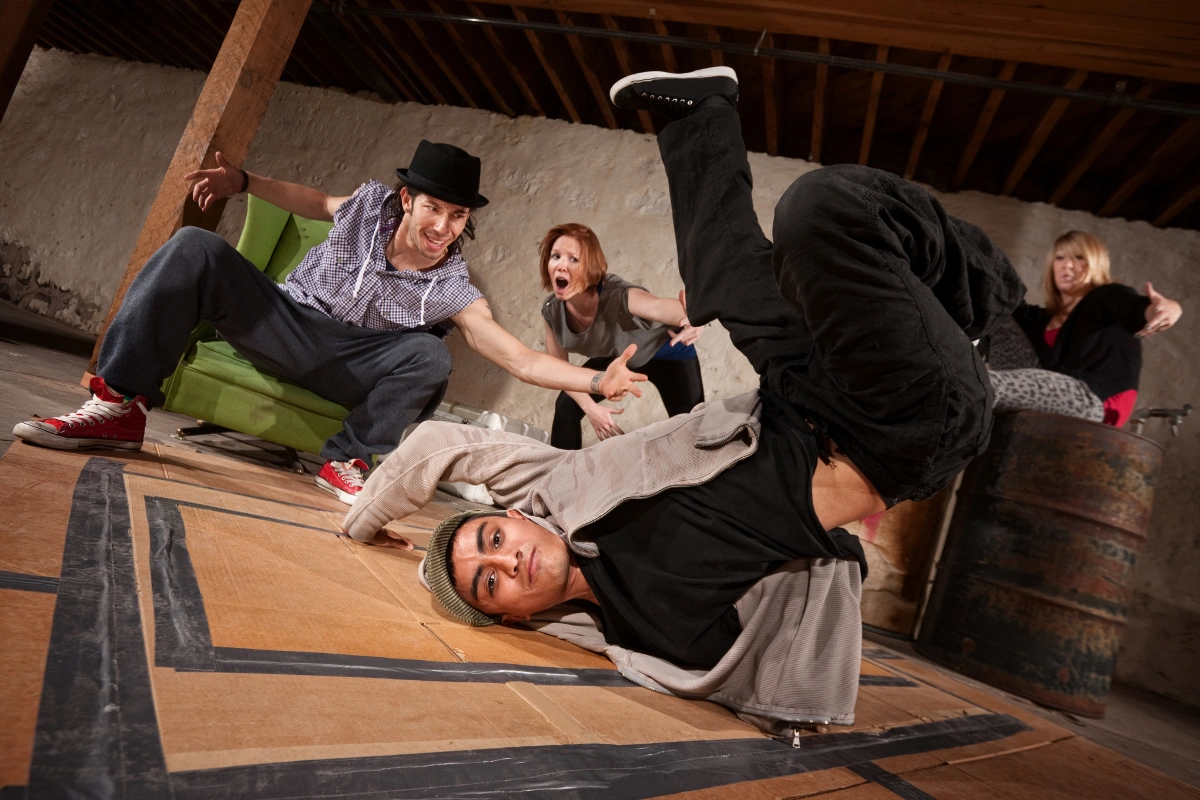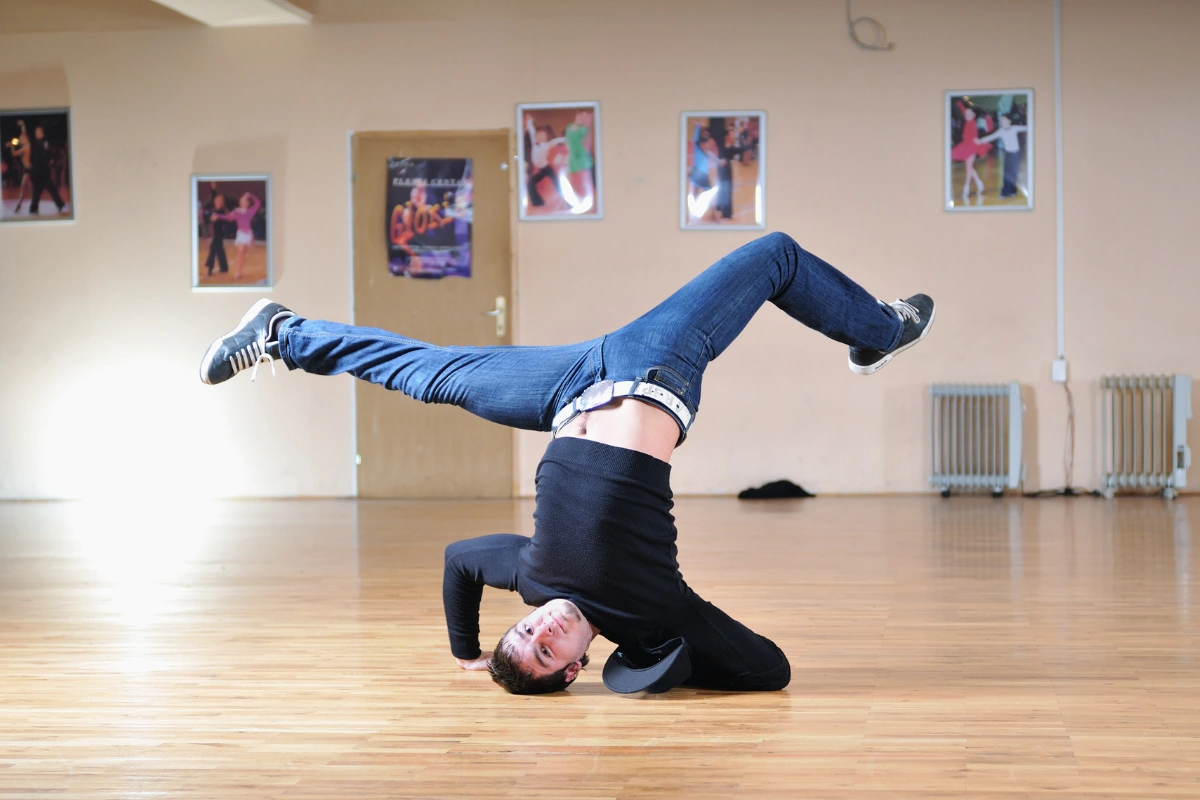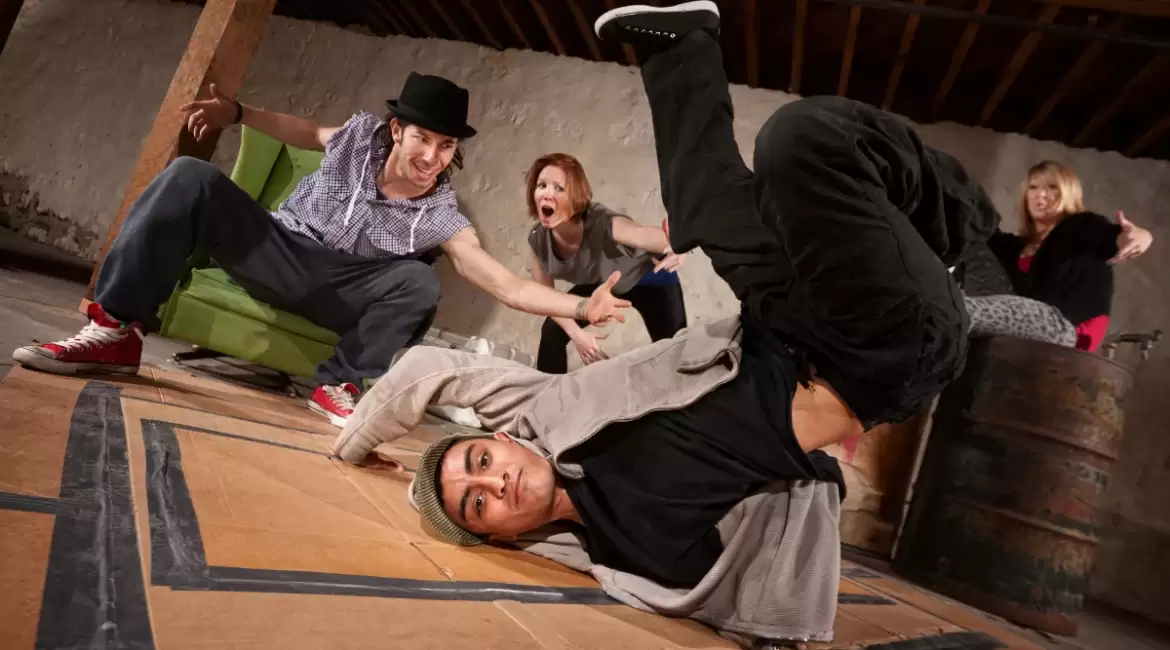In the electrifying world of breakdancing, mastering the backspin is akin to unlocking a gateway to boundless creativity and dynamism on the dance floor. As one of the foundational power moves in the breakdancing repertoire, the backspin epitomizes the fusion of athleticism, technique, and artistic expression that defines this vibrant art form.
What is a Backspin?
A backspin is a fundamental move in breakdancing that involves the breaker spinning around on their back, utilizing continuous momentum to complete multiple revolutions. When executed with precision, it resembles the smooth rotation of a vinyl record on a DJ’s turntable.
Although backspins may not boast the same visual flair as some other power moves, they consistently rank among the top 10 breakdance maneuvers due to their accessibility to beginners. Unlike more demanding power moves, backspins do not necessitate significant strength, flexibility, or balance.
Moreover, mastering the backspin is pivotal for seamlessly transitioning between power moves, as many of the foundational skills acquired during backspin practice are transferable to other maneuvers like windmills and their variations.
Variety is key in breakdancing, and backspins offer ample room for creativity and personal flair. Various interpretations of the backspin exist, each adding a unique twist to the classic move. Here are some common variations:
- California Backspin: This spin originates from a position lying on one’s back and side, initiated with a kicking motion. Historians attribute its invention to b-boy Mr. Freeze in the early 1980s.
- Hopping Backspin: Adding an extra element of dynamism, this variation involves hopping off one’s back during the spin. It was pioneered by b-boy Spider in 1984, showcasing the evolution of individual style within the dance form.
- New York Backspins: Also known as “whips,” these spins start from a “stabbed” position and are initiated with a kick similar to the California variant. B-boy Crazy Legs is credited with inventing this variation in 1980.
Even elite breakdancers incorporate these foundational moves into their routines, using them to seamlessly connect more complex maneuvers or to emphasize fluidity in their performances. As with any skill, mastering the basics before exploring variations is essential for building a strong foundation in breakdancing technique.

The History of the Backspin Move
The origin story of the backspin is a fascinating tale deeply rooted in the history of breaking, making it a captivating subject for exploration.
The inception of the backspin dates back to the mid-1970s, marking it as one of the earliest power moves to emerge within the breaking community. While its exact origins remain a topic of debate and speculation, it is widely attributed to B-boy JoJo, a prominent member of the early Rock Steady Crew, who is believed to have introduced the move to the scene around 1976. However, intriguingly, some accounts suggest that the Zulus of Southern Africa may have been the first to showcase variations of the backspin as part of their traditional dances, adding layers of cultural complexity to its narrative.
The inclusion of footwork, headspins, and backspins in traditional Zulu dancing adds an intriguing dimension to the discussion surrounding the origins of the backspin. Whether JoJo’s introduction of the move was influenced by these traditional dances or was merely coincidental remains a subject of speculation and curiosity among historians and enthusiasts alike.
Several contemporary historians posit that the backspin may have originated from a serendipitous moment, wherein JoJo inadvertently slipped while attempting a buttspin but seamlessly transitioned into the now-iconic backspin. Regardless of its exact genesis, the backspin swiftly became a cornerstone of breaking, featuring prominently in early breaking movies such as “Beat Street,” “Style Wars,” “Flashdance,” and “Wild Style,” thereby solidifying its status as a foundational move within the breaking repertoire.
For aspiring breakdancers seeking to establish a strong foundation in the art form, mastering the backspin is often regarded as an essential starting point, offering both historical significance and practical utility in the development of one’s skill set. Thus, delving into the rich history and evolution of the backspin not only provides valuable insights into the cultural heritage of breaking but also serves as a testament to the enduring legacy of this iconic move within the global breaking community.

How to Do a Backspin for Beginners
Learning how to execute a backspin is an exciting journey, especially for beginners delving into the world of breakdancing. Not only is it one of the simplest power moves to grasp, but it also serves as a fundamental building block for mastering the art of power flow and seamlessly integrating it into your dance sets.
To embark on your backspin adventure, the first step is to ensure you have the right environment conducive to spinning smoothly. Find a surface that is as flat and friction-free as possible to facilitate effortless rotation. Additionally, consider wearing clothing, such as a slick jacket, that reduces friction between your body and the floor, thereby enhancing your spinning capabilities.
Now, let’s dive into the beginner’s guide on how to execute a backspin:
Step One – Get Into the Starting Position
Embarking on the journey of mastering the backspin begins with establishing a solid foundation through the proper starting position. One of the most remarkable aspects of the backspin is its accessibility, as it doesn’t demand excessive levels of flexibility or strength, rendering it an ideal introductory move for aspiring breakers.
To initiate the backspin, assume the starting position by sitting on the floor with your legs split. Specifically, extend your right leg straight out in front of you, while bending your left leg behind you, forming a stable and balanced foundation. This positioning not only facilitates ease of movement but also ensures optimal alignment and stability throughout the execution of the spin.
It’s important to note that you have the flexibility to reverse this position if desired, enabling you to execute a counter-clockwise spin with equal proficiency. Regardless of whether you opt for a clockwise or counter-clockwise rotation, the fundamental technique remains consistent, ensuring a seamless transition between variations.
By mastering the art of positioning your body in the optimal starting stance, you set the stage for success in executing the backspin with precision and confidence. Embrace the versatility of this foundational move, and let it serve as a springboard for your journey towards mastery in the exhilarating world of breakdancing.
Step Two – Start the Spin
As you prepare to ignite the momentum necessary for the backspin, focus on the intricate mechanics of your body’s movements. Your bent leg assumes a crucial role in propelling the spin forward smoothly. With deliberate intention, initiate the spin by executing a dynamic circular motion with your bent leg, directing it towards your extended, straight leg.
Concurrently, as you kick your bent leg into motion, gradually shift your weight backward, gently lowering yourself onto the ground. This shift in weight distribution is pivotal for achieving optimal balance and stability during the spin. Aim to position yourself as high up on your back as possible, with the ideal b-boy form characterized by spinning on the region between your shoulder blades.
Refine your technique through repeated practice sessions, focusing on the fluid coordination of your movements and the precision of your kicks. Gradually increase the speed and intensity of your spins as you grow more accustomed to the sensation, striving for seamless execution and effortless rotation.
Remember, mastery of the backspin requires dedication, patience, and a commitment to refining your technique over time. Embrace the learning process, celebrate small victories, and persevere through challenges, knowing that each practice session brings you one step closer to achieving proficiency in this foundational breakdancing maneuver.

Step Three – Master the Backspin
As you become more adept at executing complete revolutions on your back, it’s time to elevate your backspin to the next level by infusing it with speed and flair. But how exactly do you achieve this?
Enter the tuck – a fundamental technique that can significantly enhance the momentum and aesthetic appeal of your backspin. Approximately halfway through your spin, initiate the tuck by swiftly drawing your knees towards your chest while simultaneously ensuring that your feet point towards the ceiling.
The tuck serves multiple purposes: it tightens your body’s rotational axis, minimizing air resistance and maximizing angular velocity, thus allowing you to spin with greater speed and efficiency. Moreover, the compacted tuck position adds a visual flourish to your backspin, lending it a dynamic and captivating aesthetic reminiscent of a spinning record on a turntable.
For those aspiring to accelerate their spins even further, incorporating strategic adjustments to your technique can yield impressive results. Experiment with intensifying the force of your leg kick and consider leveraging the power generated by your right hand to propel yourself into the desired direction of spin. By combining these subtle adjustments with the fluid execution of the tuck, you can unlock newfound speed and dynamism in your backspin, captivating audiences with your prowess and style on the dance floor.
Summary
Mastering the backspin is a fundamental skill for breakdancers, embodying the fusion of athleticism, technique, and artistic expression. In this guide, we explore the step-by-step process of executing the backspin, from establishing the optimal starting position to enhancing speed and style through strategic adjustments. With accessibility for beginners and versatility for advanced practitioners, the backspin serves as a cornerstone of breakdancing, offering dancers of all levels a platform to showcase their creativity and proficiency on the dance floor. Whether you’re just beginning your breakdancing journey or seeking to refine your technique, this guide provides a comprehensive resource to unlock the full potential of the backspin and elevate your performance to new heights.


Leave a reply